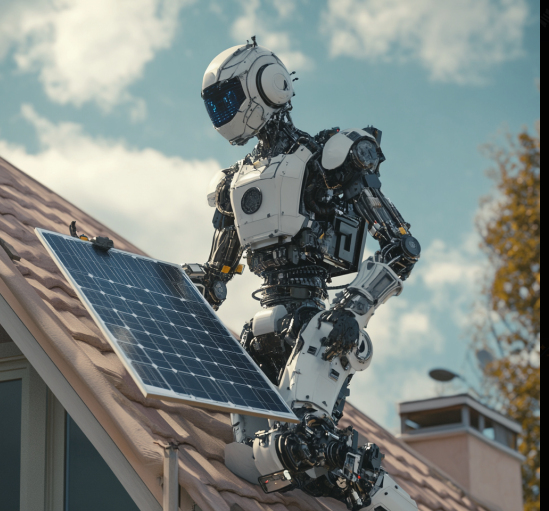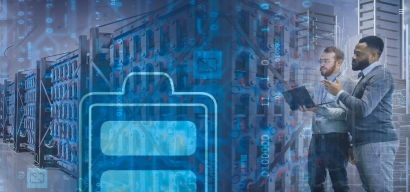
In 2024, the United States solar industry surged by installing close to 50 gigawatts direct current of capacity, a 21% rise compared to 2023, setting a new record for the second year running. But despite this growth, the workforce isn’t keeping up.
One major challenge is that there are not enough trained installers to meet the rising demand. This gap creates delays, increases labor costs and threatens project timelines. That’s where robotics comes in. Robots can assist human teams by performing repetitive and strenuous tasks. This allows fewer skilled workers to complete larger projects, freeing them to focus on technical and decision-making work. Below are a few standout examples.
Moog Construction’s semi-autonomous vehicle, CrewMate, underwent a successful field trial, showcasing its ability to assist solar workers with panel installation on challenging terrain. The vehicle efficiently transported heavy pallets loaded with large solar panels and helped workers lift and position the panels onto the racks. CrewMate’s design eased the physical strain on installers and improved safety and productivity, especially in tough outdoor conditions.
On a larger scale, AES Corporation developed Maximo, a robotic system that fully automates solar panels' movement, placement and securing on utility-scale projects. With just two people overseeing the machine, Maximo has already contributed to over 10 megawatts of installed capacity and aims to scale up to 100 megawatts by the end of 2025. This automation addresses significant labor shortages in the solar industry, particularly in remote locations where skilled workers are scarce.
Installing solar panels — especially on rooftops or large solar farms — is physically demanding and sometimes dangerous. Falls, repetitive strain injuries and heat exposure are common occupational hazards.
Robots are stepping in to make installations safer without removing the human element. Some tools help with precision and lifting — others minimize repetitive bending and walking across wide areas. These benefits protect workers and allow them to complete jobs faster and with less fatigue. Here are some examples of this human-machine synergy in action.
Rosendin developed a robotic system to make large-scale solar panel installation safer and more efficient. The robot lifts and places heavy panels using a suction-equipped arm, reducing physical strain on workers and minimizing injuries. It works with autonomous carriers and navigates tough terrain using tracks.
While fewer crew members are needed for panel placement, workers are reassigned to more complex tasks, not replaced. The system has boosted productivity, cut waste and improved safety. Rosendin is now seeking a manufacturing partner to commercialize the technology for broader use in the solar industry.
Cosmic Robotics’ robotic installer, the Cosmic‑1A, places solar panels with high precision, reducing the workload on human crews who only need to verify alignment and secure the panels. It matches top human speed — installing a panel every 30 to 40 seconds — but operates consistently without fatigue. This efficiency reduces humans' time in hot or hazardous conditions and allows teams to be split, effectively doubling output.
Automation in solar energy installation is not just a U.S. phenomenon — it’s a global movement transforming how solar projects are built and deployed. By 2028, experts expect solar and wind to supply 96% of renewable electricity, highlighting the pressing demand to accelerate the deployment of clean energy technologies.
Robotics, artificial intelligence (AI) and modular assembly techniques are streamlining installations across continents, driving down costs in a competitive industry where every cent per watt counts. The following international examples showcase how innovation can be scaled globally.
With $130 million in funding, Terabase is pioneering a fully integrated solar construction solution that combines robotics, software and AI. Their innovative mobile robotic field factory assembles and installs solar panels directly on-site, significantly speeding up project timelines and improving precision. This approach helps address labor shortages and reduces installation costs, especially for utility-scale solar farms.
Enphase Energy has launched its advanced IQ8P Microinverters in Thailand and the Philippines to support higher-powered solar panels with a peak output of 480 watts. These devices improve energy harvesting, offer detailed system monitoring and include safety features like rapid shutdown.
Backed by a 15-year limited warranty, the IQ8P is designed to meet the rising demand for residential solar in Southeast Asia, providing efficient, easy-to-install solutions that deliver strong value to users. Enphase is growing its global reach by collaborating with local partners to drive the adoption of clean and reliable energy technologies.
Rather than replacing workers, most robots in solar installation serve as valuable partners, taking on repetitive or heavy-lifting tasks and allowing crews to focus on skilled jobs like wiring and quality inspections. These innovative machines, coupled with conventional electric equipment, such as boom and scissor lifts, boost efficiency and help projects move faster without exhausting the team.
Robotics also opens new doors for workers by creating opportunities to develop skills in equipment operation and automation technology, often leading to higher pay and long-term career advancement. By handling physically demanding and hazardous tasks, robots improve jobsite safety and enable smaller teams to achieve more during labor shortages. Their precision in placing solar panels contributes to better energy output and longer system lifespan.
The growing role of automation in solar energy is reshaping jobs instead of eliminating them. There’s a rising demand for workers skilled in both renewable energy and robotics operation and maintenance.
To ease this transition, employers should support workforce development by embedding AI and automation training into educational pathways. This will prepare installers to handle robotics calibration, equip supervisors to manage hardware and software aspects of automated tools, and encourage schools to offer certifications in solar robotics. Ultimately, the workforce remains essential, just increasingly tech-savvy.
The robot revolution isn’t a threat, but a partnership. In the solar industry, robotics and automation aren’t here to displace hardworking installers. They’re here to support them, improve working conditions and fill gaps in a growing and labor-strained market.
As demand for renewable energy continues to climb, solar installers who embrace technology will have more opportunities, not fewer. With proper training, evolving roles and the right tools, solar workers will remain essential builders of a cleaner, more sustainable future.

